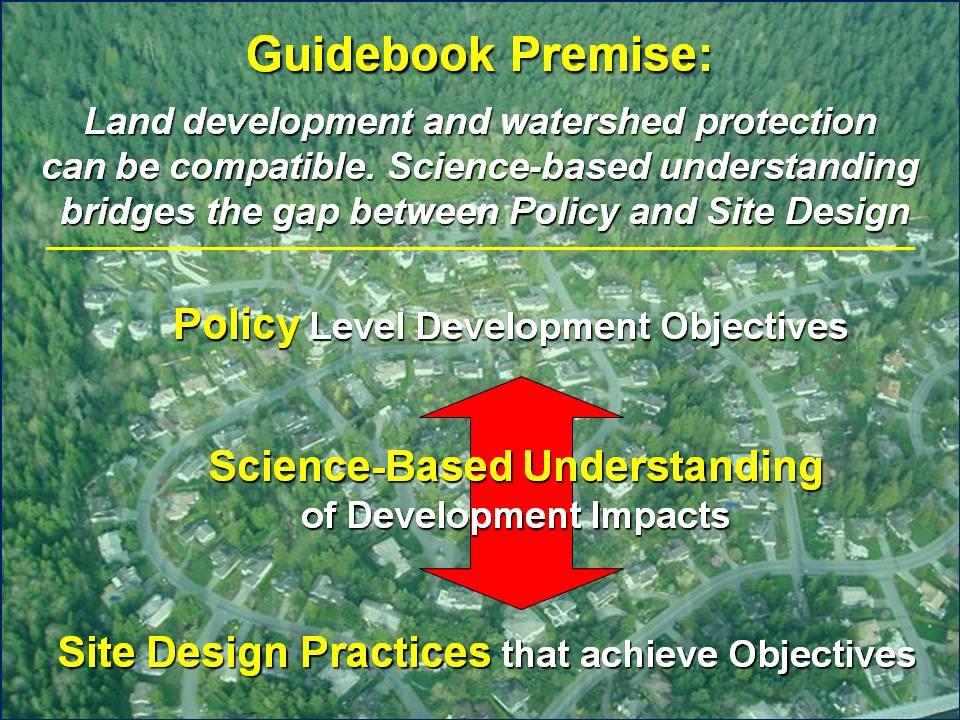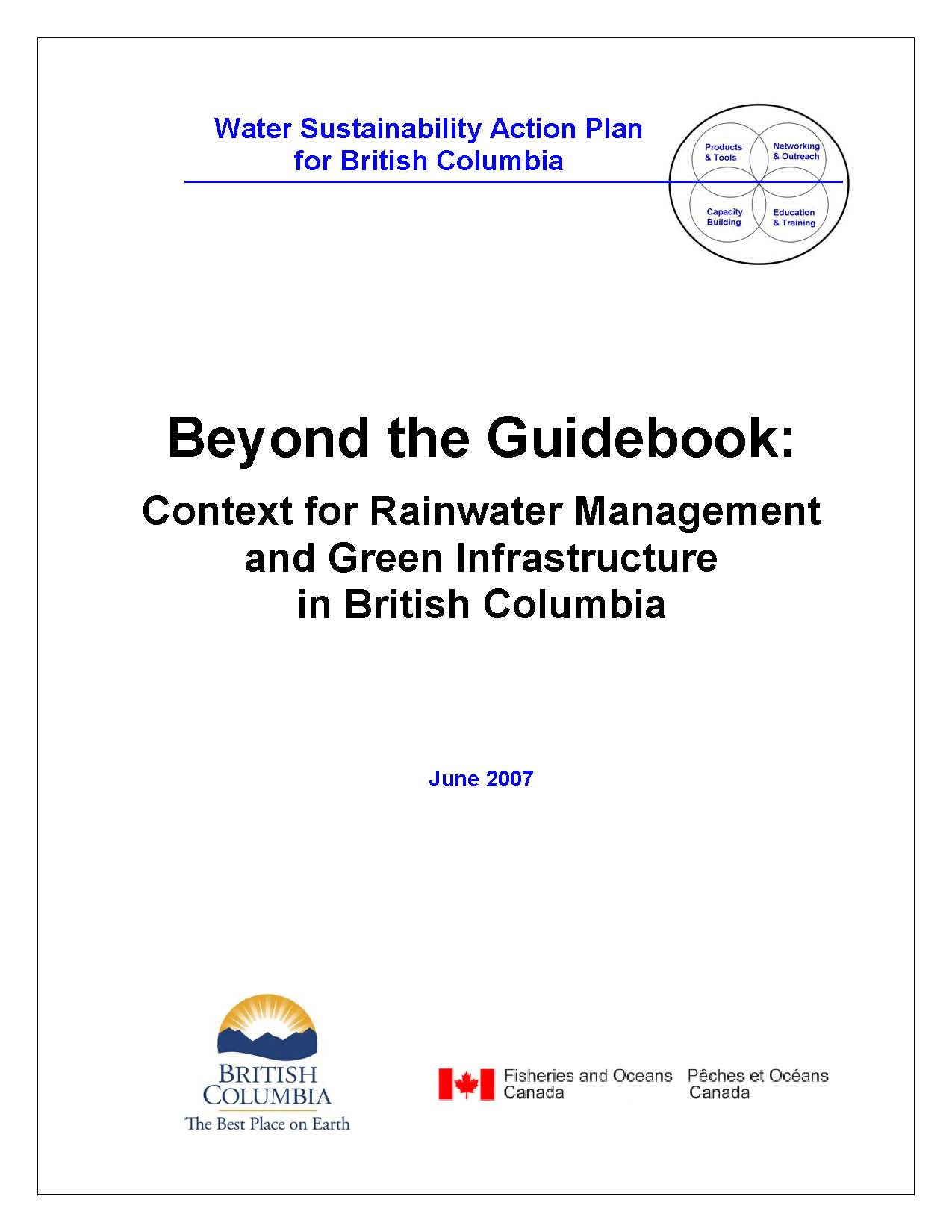DOWNLOAD BEYOND THE GUIDEBOOK 2007 – first in a series of provincial guidance documents connected dots, initiated paradigm-shift and provided local governments with "Context for Rainwater Management and Green Infrastructure in British Columbia"
Note to Reader:
The Partnership for Water Sustainability in BC is helping the Province implement the Living Water Smart and Green Communities initiatives in the local government setting. Launched in 2008, these initiatives comprise plans, strategies, targets, actions and tools to reduce the ‘water footprint’ of BC communities. The Beyond the Guidebook Initiative falls under this umbrella. Below, the original June 2007 announcement is reproduced and updated.
To download a copy, click on Beyond the Guidebook: Context for Rainwater Management and Green Infrastructure in British Columbia.
A joint deliverable of the Water Balance Model Partnership and Green Infrastructure Partnership
The Inter-Governmental Water Balance Model Partnership (IGP) and the Green Infrastructure Partnership (GIP) collaborated to produce Beyond the Guidebook: Context for Rainwater Management and Green Infrastructure in British Columbia, released in June 2007.
Water Balance Methodology and Stream Health
This guidance document initiated a paradigm-shift (change in way-of-thinking and acting). It provided context for an inter-disciplinary approach and comprehensive rainwater management by connecting the dots between Stormwater Planning: A Guidebook for British Columbia, published in 2002, and:
- the rainfall spectrum;
- performance targets;
- adaptive management;
- the Water Balance Model;
- the Green Infrastructure Partnership;
- the UBC Tree Canopy Research Project; and
- the Beyond the Guidebook initiative.
“The key message is that Beyond the Guidebook 2007 was the first guidance document to connects the dots between the Water Balance Methodology (that is at the heart of the Guidebook) and stream health protection. This breakthrough was transformational because it allowed drainage practitioners to develop a watershed approach that addresses stream protection and/or restoration,” states Kim Stephens,  Executive Director of the Partnership for Water Sustainability in BC.
Executive Director of the Partnership for Water Sustainability in BC.
A decade later, the Partnership is responsible for ongoing evolution of the Beyond the Guidebook Initiative. This is being accomplished through shared responsibility with government in delivering the Water Sustainability Action Plan for British Columbia.

Protect Stream Health
The Guidebook’s premise that land development and watershed protection can be compatible represented a radical shift in thinking in 2002. An educational objective was that practitioners would view the watershed and its streams from a much more holistic perspective.
Manage Volume, Mimic Runoff Pattern
 “The Guidebook recognized that water volume is something over which local government has control through its infrastructure policies, practices and standards,” stated Ted van der Gulik, IGP Chair, when Beyond the Guidebook was released in 2007.
“The Guidebook recognized that water volume is something over which local government has control through its infrastructure policies, practices and standards,” stated Ted van der Gulik, IGP Chair, when Beyond the Guidebook was released in 2007.
Beyond the Guidebook is an initiative that builds on this foundation by advancing a runoff-based approach and tool – the ‘Water Balance Model powered by QUALHYMO’– to help local governments achieve desired urban stream health and environmental protection outcomes at a watershed scale.”
Capture Rain, Where It Falls
“Through implementation of ‘green infrastructure’ policies and practices, the desired outcome in going Beyond the Guidebook is to apply what we have learned at the site scale over the past five years…so that we can truly protect and/or restore stream health in urban watersheds”, added Paul Ham, GIP Chair (2005-2008). 
“The early success of the GIP built awareness and galvanized action on the ground. This success helped to lay a strong foundation for incorporation of the Partnership for Water Sustainability in BC. This entity is now the hub for a ‘convening for action’ network in the local government setting, and the keeper of the GIP legacy,” stated Paul Ham in 2014.
Provincial Government Direction
 The BC Ministry of Community Services was a member of the steering committees for both partnerships.
The BC Ministry of Community Services was a member of the steering committees for both partnerships.
“Provincial grant programs no longer support the traditional ‘pipes and pavement’ approach to drainage planning. The focus of the Ministry of Community Services is on programs that reduce rainwater runoff volume at the site level, by capturing rain where it falls”, stated Glen Brown, former Director of Infrastructure and Engineering, when Beyond the Guidebook was released in 2007. A decade later, Glen Brown is General Manager (Victoria Operations) with the Union of BC Municipalities.
To Learn More:
Download and read a copy of Beyond the Guidebook: Context for Rainwater Management and Green Infrastructure in British Columbia, released in June 2007.



